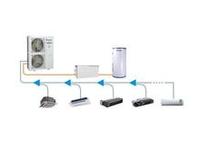
According to monitoring by Beijing's environmental protection department, in this year's hazy weather, PM2.5 pollution caused by coal-fired central heating accounts for more than 50% of the total, exceeding the pollution of automobile exhaust.
In fact, it is precisely because the haze pollution caused by coal burning is very serious. Many countries in the world are controlling the emission of coal by controlling the haze. Therefore, how to reduce the amount of coal burning has naturally become the primary goal of haze management in China.
According to statistics, heating in northern cities, mainly relying on cogeneration, coal-fired, gas, and electricity, is the largest area for energy consumption in China's buildings. The heating area is 8.8 billion m2, and energy consumption is 150 million tons of standard coal, accounting for national energy. The consumption of 7% will be 40% of the national urban building energy consumption; by 2020, the heating area may increase to 12 billion m2, and the energy consumption data will be even more striking.
Due to the large amount of coal burning caused by central heating, alternatives to coal-fired heating have attracted attention from all walks of life. It is reported that Gree's high-efficiency heat pump technology represented by Gree's self-developed "double-stage heat pump technology" may become an important feasible solution for pollution-free heating due to its high-efficiency and energy-saving features.
Some experts said that Gree has mastered the "two-stage variable frequency heat pump technology", can promote the revolutionary changes in the winter heating mode in southern and northern China. The test results of the National Engineering Research Center for Energy-saving and Environmental-protection Refrigeration Equipment show that after this technology is adopted, not only can the residents' heating effect be effectively guaranteed, but also the primary energy consumption can be reduced by 40% compared to the conventional centralized heating. In particular, this technology has broken through the limitations of traditional ultra-low-temperature heating of heat pump technology, and also solved the technical problems of large heat attenuation at low temperature and low energy efficiency of general heat pump air conditioners, and broadened the range of product use (-30°C to 54°C). Significantly increased low-temperature heating. From the perspective of ultra-low temperature heating performance, it can meet the heating needs of most of China's cold regions.
In fact, about Gree's innovative technology has achieved good results in Shijiazhuang. The country’s largest industrial waste heat pump heating project—industrial waste heat pump heating project around Shijiazhuang Circulation Chemical Industry Base. The Lijingwan Community is 100,000 square meters. The gas boiler was used in the previous year. The heating cost is high, and heat insulation occurs from time to time. Last year it was replaced by Gree efficient DC variable frequency heat pump centrifuge. It used a two-stage compression variable frequency heat pump technology to run for a winter season. The indoor temperature was stable and the energy consumption was reduced by more than 40%.
It is reported that, in addition to solving 21.15 million square meters of civil building heating, the industrial waste heat pump heating project around the Shijiazhuang Circulation Chemical Base can save 630 acres of land, save 5.4 million tons of standard coal, save 4.954 million tons of water, and reduce waste heat. 8.3×105GJ/year, reduction of carbon dioxide emissions by 1.438 million tons/year, reduction of sulfur dioxide emissions by 4,668 tons/year, reduction of nitrogen oxide emissions by 4,064 tons/year, and reduction of dust emissions by 879 tons/year have achieved energy conservation and emission reduction benefits. Solve the problem of livelihood heating.
According to experts, the dual-stage compression variable-frequency heat pump technology can completely solve this problem on the basis of ensuring comfort and economy, with 2.1 tons of standard coal for each household heating, and 100 million households not included in the central heating calculation in winter. Reduce emissions of 332 million tons of carbon dioxide (equivalent to 1.5 carbon dioxide absorbed by the Greater Khingan Mountains annually), 143 million tons of soot, and 15.75 million tons of sulfur dioxide; pilot data from the National Engineering Research Center for Energy-saving and Environmental-friendly Refrigeration Equipment in Hebei, Heilongjiang, etc. With this technology, not only can the residents' heating effect be effectively guaranteed, but also the primary energy consumption can be reduced by 40% when compared with centralized heating. The significant reduction in energy consumption is the guarantee for the “green and economical” heating mode. For non-central heating users (according to 100m2 calculation), the original winter heating costs 2100 yuan, after the promotion of new technology was reduced to 1254 yuan (calculated by double-level air conditioning), heating costs decreased 846 yuan, a decrease of 40.3%; for centralized heating users (According to 100m2 calculation), the original winter heating costs 2,400 yuan, after promotion to 1,254 yuan (calculated by two-stage air conditioning), heating costs decreased by 1146 yuan, a decrease of 47.8%; if there is a heat source (recyclable industrial waste heat, urban Sewage, etc.) The use of a two-stage compression centrifuge unit can save an additional 12% on the above-mentioned basis, and the economic benefits are even more pronounced.
Experts said that at present, China’s per capita energy reserves are far below the world’s average, and continued high growth increases the pressure on resources and the environment. Gree’s “two-stage variable frequency heat pump technology” can promote the revolutionary changes in the heating mode in winter. Promoting this new type of low-carbon heating technology for the benefit of people's livelihood will play a major positive role in achieving sustainable economic development and building an ecological civilization.

 According to monitoring by Beijing's environmental protection department, in this year's hazy weather, PM2.5 pollution caused by coal-fired central heating accounts for more than 50% of the total, exceeding the pollution of automobile exhaust.
According to monitoring by Beijing's environmental protection department, in this year's hazy weather, PM2.5 pollution caused by coal-fired central heating accounts for more than 50% of the total, exceeding the pollution of automobile exhaust. 
